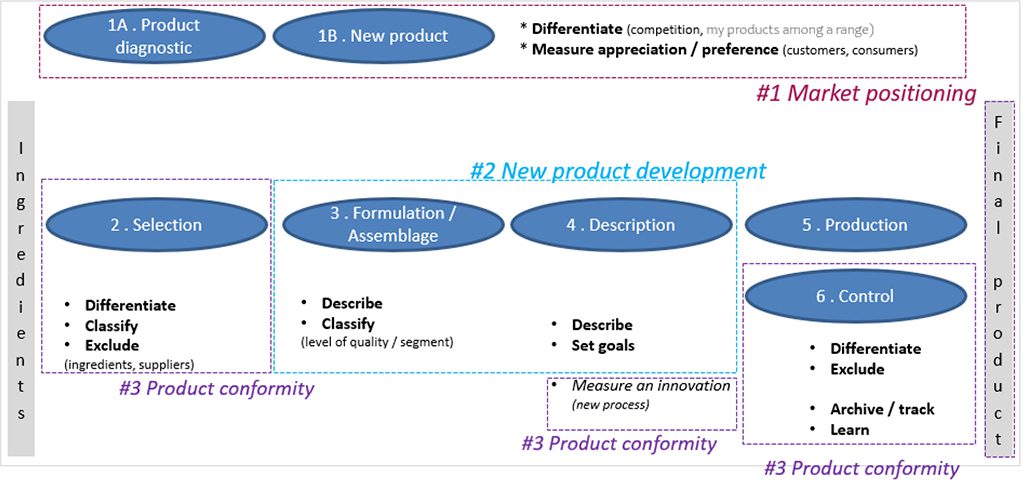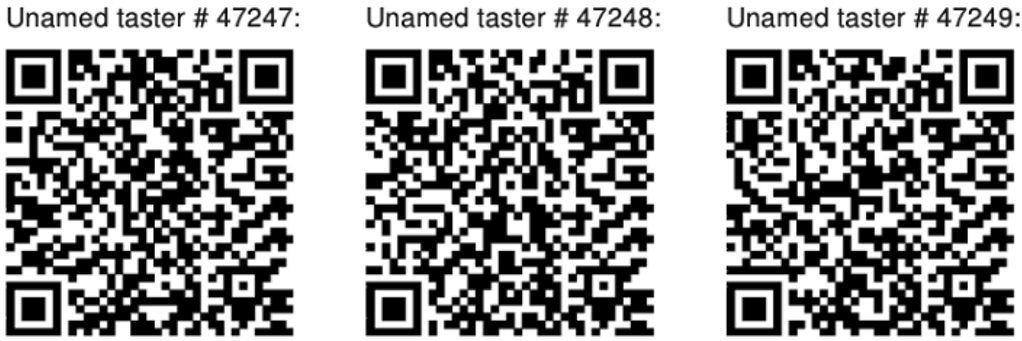The objective of consumer sensory tests or “affective tests” is to differentiate food products based on consumer preference levels. Assessors should be familiar with the food or beverage that they are assessing for taste and flavor so that they may express degrees of product acceptance, preference, or dislike. An adequate number of observations should be collected in order to perform some market analysis and segmentation.
Product lifecycle & application of sensory analysis methods

Consumer tests are an important part of the new product development (NPD) cycle. From formulation and selecting the right ingredients to develop new food prototypes and bringing finished products to the commercialization stage, consumer sensory tests can help target sensory profiles for specific markets and ensure customer acceptance and liking. One application of consumer sensory tests is competitors’ analysis, where two or more products are served to a consumer panel to determine their degree of liking and the likelihood that they will re-purchase the product.
Creating a consumer test in Tastelweb® is intuitive. The web interface guides you through 6 easy steps.
Step 1 Test description, Number of Panelists, Presentation Order
After completing the introductory page to your sensory test, you will be asked to choose a time slot for your project with a start date and an end date. This will define the time frame that respondents will have to access and complete your questionnaire and product tasting. After the selected time window, panelists will no longer be able to respond; your sensory test will be closed. Consumers can respond at different times and from different locations, provided they have access to the product.
Then comes the selection of the “judges.” You must indicate the number of participants for your consumer test. Tastelweb® gives you the possibility to choose a number between 1 and 200!
You will need to obtain feedback from at least 60 consumers to get meaningful results (i.e., statistical power). For such a sensory test, respondents are not professional assessors. They are not expected to rate the quality of the product but only provide their hedonic response: do they prefer the taste of product A over products B and C? Your panel should correspond to the target consumers who will purchase your product.
You will then enter the mode of product evaluation. The assessment will either follow a monadic or compared order.
Monadic order: consumers will answer the questionnaire/sensory ballot and evaluate one product at a time.
Compared order: Consumers will evaluate all products at one time and will be able to make comparisons.
Step 2 Product Selection
Consumer tests in Tastelweb® are modular. They may include a questionnaire with or without a tasting component. For instance, consumers may be asked to review a product label, comment on food packaging as well as provide demographic information. When adding a product evaluation, consumers may be asked to provide feedback by giving short or long answers, by answering multiple choice questions, or by rating certain attributes or overall sensory quality using scales.
It is recommended not to include more than six products for a sensory evaluation. Note that if the number of products is fewer than 3, PCA plots, dendrograms, and ANOVA test, results won’t be available in the report section.
Products may be added manually or imported from an Excel file or directly selected from the Tastelweb® database.
The product tasting order is then selected. You have the choice to select a free, randomized, or balanced order of presentation (“Latin square design”). You can also select no order, in which case the products will be presented to all panelists, starting with the first product on your product list.
Step 3 – Questionnaire Design
The questionnaire comprises three sections:
- Demographics: consumer age, gender, consumption habits, and place of purchase.
- Product assessment: overall liking, main qualities/faults, specific questions on an attribute (degree of sweetness?), classification, etc.
- Final summary: overall opinion on the product category, consumer availability for another tasting, etc.
You may choose different types of questions: open-ended questions, multiple choices, scales, CATA, cross tables, JAR scales, or a 9-point hedonic scale.

Note: Textual analysis is currently available for long answer questions. This feature allows you to create and save a dictionary of sensory attributes, including synonyms for each product category.
Step 4 Instructions, Online Help, and Acknowledgments
In this section, windows will appear to allow you to write an invitation to participate in the sensory test. You will also be able to provide access to online help and finalize/thank customers for their time.
It is possible in Tastelweb® to customize your email messages to the panelists. The online help is provided using text, images, Word/PDF, or video format (the video is hosted on YouTube in private mode, only panelists with access to the link will have access).
Step 5 – Test Preview
In this section, you can preview the questionnaire and perform a mock sensory test. You are also able to download the running order of samples, a document that the sensory panel coordinator will use as a reference to serve the samples to the panel. The running order of samples is critical during blind tasting since it matches a product description to a 3-digit product number.
Step 6 – Finalizing and Sending the Sensory Test to the Panel
In this last step, you can send the tasting invitations to the panelists using three methods:
- Send by email
- Via QR code
- Via URL (with ID user, password).
Reminder: 200 participants can access your consumer test, which makes it easy to perform a live test during a trade show, conference/event, or class presentation.
You can create consumer groups or select a pre-defined sensory panel. Once the panel has been selected, there is the possibility to send it by email by communicating a QR code or a participation URL. It is possible to edit the list and exclude certain panelists.

Reporting
Once the consumer test is completed (60 responses are recommended), results are immediately accessible. Sensory data is tabulated and graphed. For the creation of the report, you may select the following test results and graphical outputs:
- Single answer questions: Distribution of choices
- Rating questions: Mean, Standard Deviations, and Table of Values
- PCA plots and dendrograms
- Distribution Histograms
- Analysis of Normality
- Product comparisons by Rank and by Means.
Example of consumer test results showing a histogram of responses using the 9-point hedonic scale for three categories of baked goods. At the top, tabulated values of consumer responses based on choice (Confidence levels: ***(<=0.1%) **(<=1%) *(<=5%))
Statistical Results
Normal standardization of data is checked by Khi2 and/or Kolmogorov Smirnov test(s).
This standardization study allows to select the appropriate statistical test to use:
* If the data distribution for an attribute is accepted, and in the case of two products, a Student test is conducted, or in the case of more than two products, an ANOVA test is conducted. Pairwise Comparisons among means use your choice of Fisher’s LSD, Duncan’s, or Newman-Keuls tests.
* If the data distribution for an attribute is rejected, and in the case of two products, a Willcoxon test is conducted, or in the case of more than two products, a Friedman test on ranks is conducted.
References:
Sirocco Consulting – Sensory Consulting Services
Pangborn Sensory Symposium 2023
Interested in taking a food safety course? Karine Lawrence from Sirocco Food + Wine Consulting teaches virtual and on-site HACCP, PCQI, SQF implementation systems, and Food Defense courses. Refer to our website for a list of upcoming courses.






